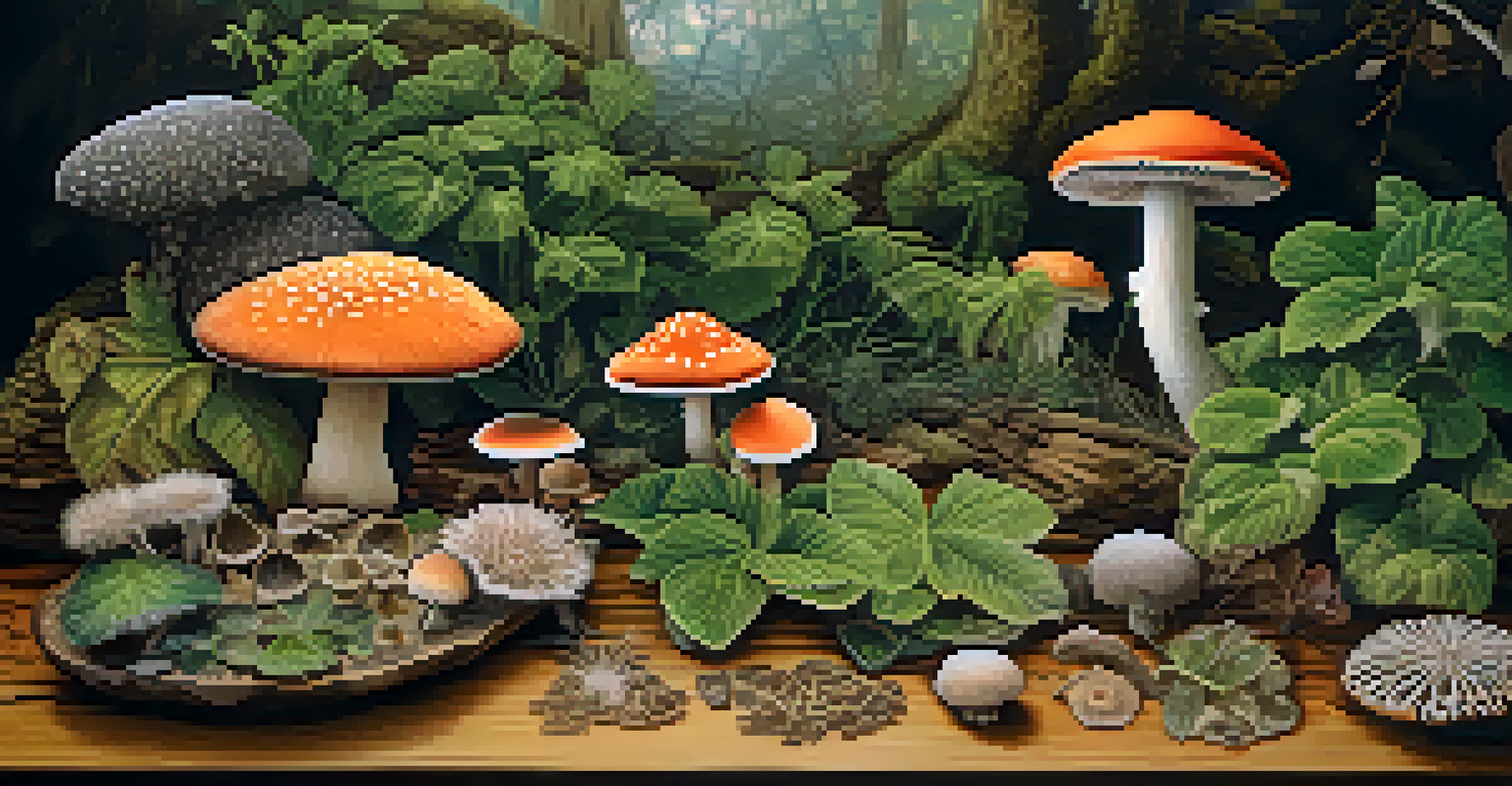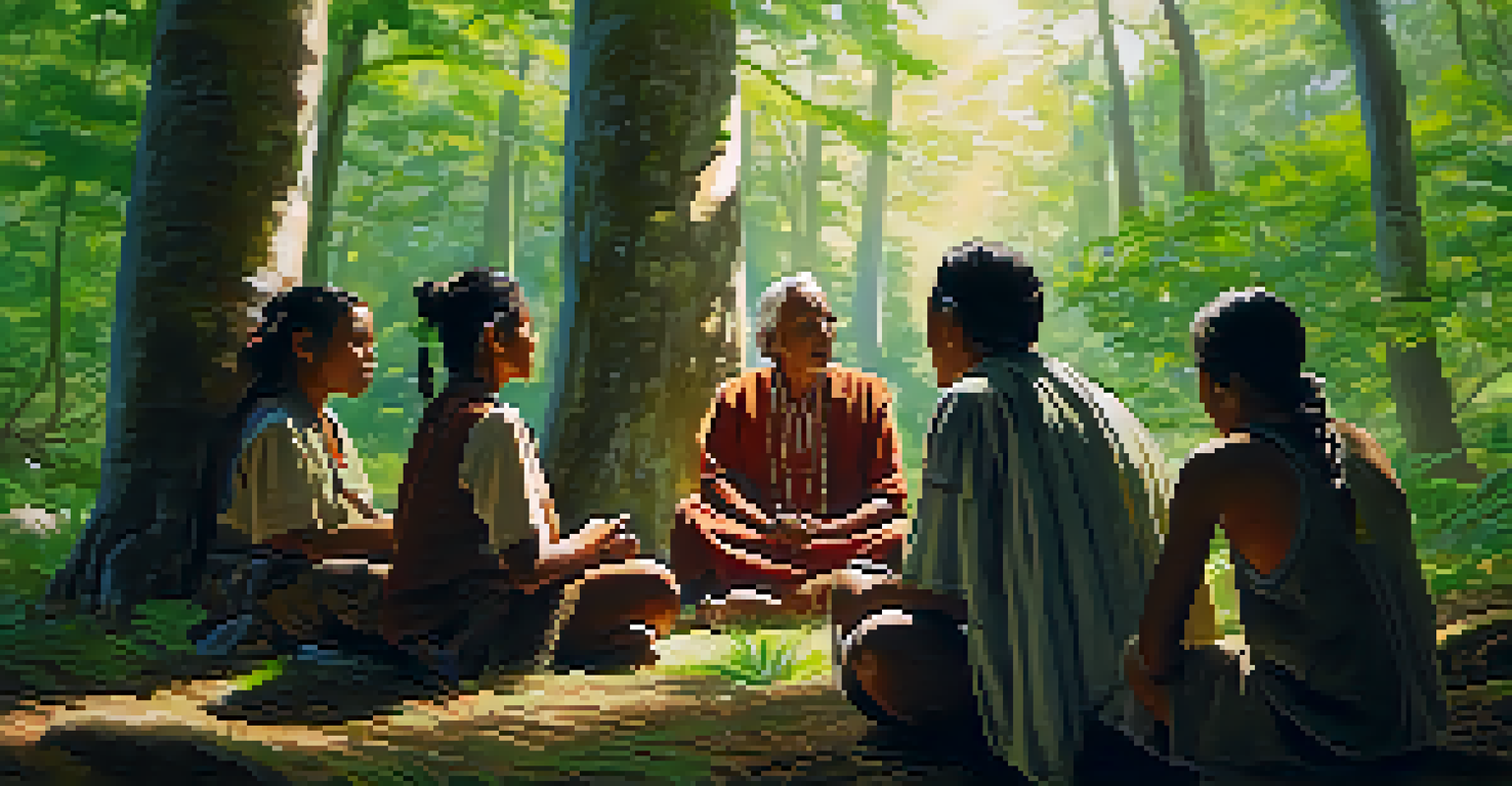Exploring Indigenous Educational Practices with Entheogens

Understanding Entheogens in Indigenous Cultures
Entheogens are substances used in various Indigenous cultures to facilitate spiritual experiences and enhance learning. These natural substances, like psychedelics, are often integrated into rituals and educational practices. For many Indigenous communities, entheogens are not just tools for personal insight but also serve as a bridge to communal knowledge and wisdom.
The use of entheogens is deeply rooted in Indigenous cosmologies, where they are seen as sacred teachers.
By engaging with these substances, individuals can access altered states of consciousness that promote introspection and connection with the natural world. This deepened awareness is a crucial aspect of Indigenous knowledge systems, where understanding is often gained through experiential learning rather than traditional classroom settings. Thus, entheogens play a significant role in shaping both individual and collective identities.
Moreover, the use of entheogens is deeply rooted in Indigenous cosmologies, where they are seen as sacred teachers. This perspective encourages respect not only for the substances themselves but also for the cultural practices surrounding them. As we explore these educational practices, it becomes clear that entheogens are intertwined with the very fabric of Indigenous life.
Historical Context of Entheogen Use
Entheogen use in Indigenous cultures dates back thousands of years, with various plants and fungi serving as central elements in spiritual and educational rituals. For instance, the use of peyote among Native American tribes highlights how these substances were historically employed to foster community bonds and transmit cultural teachings. Understanding this historical context is essential for appreciating their contemporary applications.

These practices have survived colonial efforts to suppress Indigenous knowledge, often adapting to new social and cultural landscapes. As Indigenous peoples continue to reclaim their traditions, the use of entheogens has gained renewed interest as a means of resistance against cultural erasure. This resilience underscores the importance of these practices in maintaining cultural identity and continuity.
Entheogens Enhance Indigenous Learning
Indigenous cultures use entheogens as tools for spiritual experiences and communal knowledge, emphasizing experiential learning.
Additionally, modern anthropological research has documented these traditional uses, providing insights into how entheogens facilitate unique learning experiences. By examining historical records and contemporary testimonies, we can see how entheogens have shaped educational paradigms within Indigenous communities, emphasizing holistic approaches that honor both the mind and spirit.
The Role of Rituals in Learning
Rituals are an integral part of Indigenous educational practices, providing a structured environment for the use of entheogens. These ceremonies often involve music, storytelling, and communal participation, creating a rich tapestry of experiences that enhance learning. Such rituals not only facilitate personal transformation but also strengthen community ties, fostering a sense of belonging and shared purpose.
By engaging with these substances, learners can explore their inner landscapes, uncovering personal insights that inform their understanding of the world.
During these ceremonies, participants may undergo profound experiences that lead to insights about themselves and their place within the community and the wider world. This experiential learning contrasts sharply with conventional educational methods, emphasizing the importance of direct experience over rote memorization. By integrating entheogens into these rituals, Indigenous educators create a transformative learning experience that resonates on multiple levels.
Furthermore, the communal aspect of these rituals enriches the educational process, as knowledge is shared and co-created among participants. This collaborative learning environment reflects the collective nature of Indigenous cultures, where wisdom is seen as a communal asset rather than an individual pursuit. Through rituals, the teachings of the ancestors are passed down, ensuring that cultural heritage remains vibrant and relevant.
Experiential Learning and Personal Growth
Experiential learning is a cornerstone of Indigenous education, and entheogens play a pivotal role in this process. By engaging with these substances, learners can explore their inner landscapes, uncovering personal insights that inform their understanding of the world. This journey of self-discovery often leads to personal growth, empowerment, and a deeper connection to one's cultural roots.
For many, the use of entheogens offers a powerful means of healing, helping individuals confront trauma and gain clarity. This therapeutic potential is particularly significant in Indigenous communities, where historical and ongoing injustices have left deep scars. By facilitating emotional and spiritual healing, entheogens contribute to a more holistic approach to education that values mental, emotional, and spiritual well-being.
Rituals Foster Community and Insight
Rituals involving entheogens create structured environments for learning, strengthening community ties and personal transformation.
Moreover, the lessons learned during these transformative experiences are often shared within the community, enriching the collective knowledge base. This sharing process not only reinforces individual growth but also strengthens community bonds, creating a supportive environment for ongoing learning. Thus, the integration of entheogens into educational practices fosters both personal and communal development.
Challenges and Misunderstandings
Despite their rich history, the use of entheogens in Indigenous educational practices faces numerous challenges and misunderstandings. One major issue is the stigma surrounding entheogens, often viewed through the lens of Western drug culture rather than their cultural significance. This misrepresentation can lead to a lack of respect for the traditions and teachings associated with these substances.
Additionally, appropriation of entheogenic practices by non-Indigenous individuals can undermine their cultural integrity. When these practices are removed from their sacred context, they risk becoming mere entertainment or novelty experiences. This highlights the importance of understanding the deep cultural roots of entheogen use and respecting the knowledge and traditions of Indigenous peoples.
Furthermore, legal restrictions and societal misconceptions about entheogens can limit access to these powerful educational tools. Advocacy for the rights of Indigenous communities to practice their traditions is crucial in ensuring that these practices can continue to thrive. Addressing these challenges requires a broader cultural shift that honors Indigenous wisdom and promotes understanding.
Modern Applications of Indigenous Knowledge
In recent years, there has been a growing interest in integrating Indigenous knowledge into mainstream education, particularly with the resurgence of entheogenic practices. This interest reflects a broader recognition of the value of holistic, experiential learning approaches. By incorporating Indigenous perspectives, educators can enrich their curricula and create more inclusive learning environments.
Some universities and educational institutions are beginning to collaborate with Indigenous communities, seeking to learn from their approaches to education and entheogen use. These partnerships can help bridge the gap between traditional knowledge and contemporary educational practices, fostering mutual understanding and respect. Such collaborations emphasize the importance of place-based learning, where students engage with local ecosystems and cultural histories.
Challenges in Entheogen Practices
Entheogen use faces stigma and appropriation issues, highlighting the need for respect and understanding of Indigenous traditions.
Moreover, the increasing acceptance of entheogens in therapeutic settings has prompted a reevaluation of their role in education. As more people recognize the potential benefits of these substances for personal and communal healing, there is an opportunity to reframe the conversation around entheogens. By highlighting their educational value within Indigenous contexts, we can foster a more nuanced understanding of their significance.
The Future of Indigenous Educational Practices
As we look to the future, the role of entheogens in Indigenous educational practices is likely to continue evolving. With a growing interest in mindfulness, spirituality, and holistic education, there is potential for these practices to gain wider recognition and respect. This shift could lead to increased collaboration between Indigenous and non-Indigenous educators, fostering a richer learning environment for all.
Moreover, as research into the benefits of entheogens expands, there may be greater support for Indigenous communities to reclaim and revitalize their traditional practices. This resurgence can serve as a powerful reminder of the importance of cultural heritage and the wisdom embedded within Indigenous knowledge systems. By prioritizing these practices, we can help ensure that they remain vibrant and relevant for future generations.

Ultimately, the future of Indigenous educational practices lies in a commitment to respect, collaboration, and understanding. By embracing the lessons of the past and present, we can create a more inclusive educational landscape that honors the profound teachings of Indigenous cultures. This journey involves not just recognizing the value of entheogens but also appreciating the rich tapestry of knowledge that Indigenous peoples have to offer.